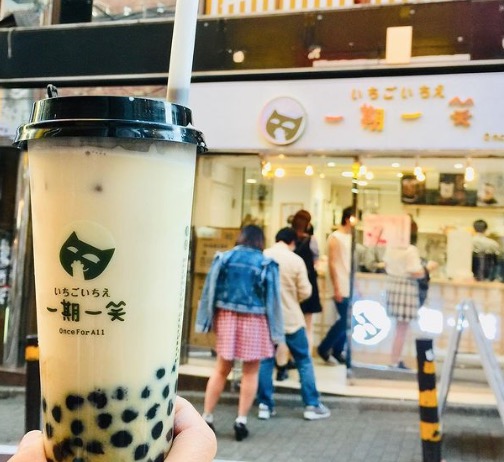What are the popular milk tea shops in Japan? What is the development trend of Japanese pearl milk tea market?
The recent craze of pearl milk tea in Japan has not only surpassed Taiwan in terms of the number and penetration of shops, but there are at least 400 specialty stores in Tokyo alone, not counting other coffee shops, restaurants, convenience stores and vending machines that sell similar tea drinks. Apart from the Pearl Milk Tea Research Association set up by Waseda University, there are even a number of college girls who claim to be "pearl milk tea tasters", claiming that they have patronized thousands of shops and drank 27 cups of tea a day.

The "rare milk fever" has already expanded to multinational markets around the world, not only in Japan, but also in multinational markets around the world, creating a trend. Behind the upsurge, economists are actually not optimistic about the development trend of this tea trend, believing that it will not last long, and that precious milk fever is a harbinger of a stock market crash on the Internet. Is this precious milk craze coming to an end?
In fact, Taiwan tea such as Pearl Milk Tea has landed in Japan for nearly 30 years. As early as the early 1990s, Taiwanese enterprises such as Kuaikoli and EasyWay moved in, making local people taste the taste of precious milk for the first time. In the 2000s, some Japanese enterprises even launched pearl milk tea in convenience stores, making rare milk drinks everyday. The pearl milk tea is the third wave of the local craze, which can be traced back to at least 2013 when Chunshuitang, one of the ancestors of pearl milk tea, opened a local shop, making Taiwan tea popular again. The rise of social media has also led to the spread of this craze.
In the past two years, the development rate of Japanese tea is very amazing. According to the Imperial Database, turnover in December 2018 increased tenfold compared with the same period in 2016, with long queues of tea shops, large and small. The global tea market was worth US $1.96 billion (HK $15.3 billion) in 2016 and is expected to grow to US $3.21 billion (HK $25 billion) by 2023, according to research firm Allied Market Research. North America is currently the fastest growing region, accounting for more than 57% of the market. In addition, the European market is also growing rapidly, with a compound annual growth rate of 9.1%. It can be seen that this rare milk fever is not limited to Japan.
In fact, economics calls this phenomenon "Market Anomaly". For example, the famous "January Effect effect" in the United States refers to stocks that perform poorly in the fourth quarter and will perform well in the first quarter of next year. In Japan, in recent years, there has also been a saying that "whenever artists get married, the stock market will fall."
These market anomalies usually stem from non-economic factors such as investor psychology, tax system or trading time. In terms of the January effect, some studies have pointed out that it is related to the use of tax return dates by American investors to save taxes. On the other hand, in the case of Japan, it is because investors believe that they are preconceived, so whenever an artist announces marriage, he sells the stock quickly, causing the stock market to fall for a while, resulting in a reversal of causality.
Going back to the rare milk craze, since it has only happened twice at present, and both happened to be hit by the collapse of the bubble economy, it is easy to be copied by those who are willing to do so. However, this coincidental situation is difficult to determine the exact causal relationship between the two, and may be more penetrating.
The prospect of rare milk is ideal?
So, can rare milk fever be maintained in Japan and around the world? Let's start with Japan, the garbage problem is one of the major problems. Rubbish bins are rarely set up on the streets of Japan, and drinking precious milk cups is a headache. Because it has a large capacity and is easy to leak, it is difficult to put it in the bag. At present, some of the concentrated areas of rare milk stores in Japan have been discarded everywhere.
As for the global boom, Singapore marketing expert Jacky Tan pointed out that the tea market is more booming than it was a few years ago, and the entry threshold of the industry has been raised as many high-level enterprises have entered the market. Today, the diversification of the tea market is also different from the singleness in the past, which eventually leads to vicious price competition among enterprises, resulting in the closure of many shops due to operational difficulties.
However, some economists predict that in the past, rare milk fever generally did not last long, and could only last for a few months at most. When more and more shops of the same type open, people's interest in this area will greatly fade. This business model can generally bring short-term profits for enterprises, long queues can also receive publicity, but it is difficult to be called a sustainable business model in the long run.
Important Notice :
前街咖啡 FrontStreet Coffee has moved to new addredd:
FrontStreet Coffee Address: 315,Donghua East Road,GuangZhou
Tel:020 38364473
- Prev

How long does coffee taste? How do expired beans taste good? How long does coffee last?
Before Guangzhou, because of the epidemic situation (how many times we tested nucleic acid a month), many guests hoarded a lot of coffee beans at one time, so we all know that cooked beans have a taste appreciation period, beyond the period flavor will decline. Today's article tells you how to judge the taste of coffee and how to save expired coffee beans. Coffee in general.
- Next

The principle of step-by-step three-stage extraction of hand Coffee & the Flavor characteristics of Coffee
Professional coffee knowledge exchange more coffee bean information please follow the coffee workshop (Wechat official account cafe_style) more boutique coffee beans please add private Wechat Qianjie coffee, WeChat: kaixinguoguo0925
Related
- Beginners will see the "Coffee pull flower" guide!
- What is the difference between ice blog purified milk and ordinary milk coffee?
- Why is the Philippines the largest producer of crops in Liberia?
- For coffee extraction, should the fine powder be retained?
- How does extracted espresso fill pressed powder? How much strength does it take to press the powder?
- How to make jasmine cold extract coffee? Is the jasmine + latte good?
- Will this little toy really make the coffee taste better? How does Lily Drip affect coffee extraction?
- Will the action of slapping the filter cup also affect coffee extraction?
- What's the difference between powder-to-water ratio and powder-to-liquid ratio?
- What is the Ethiopian local species? What does it have to do with Heirloom native species?

